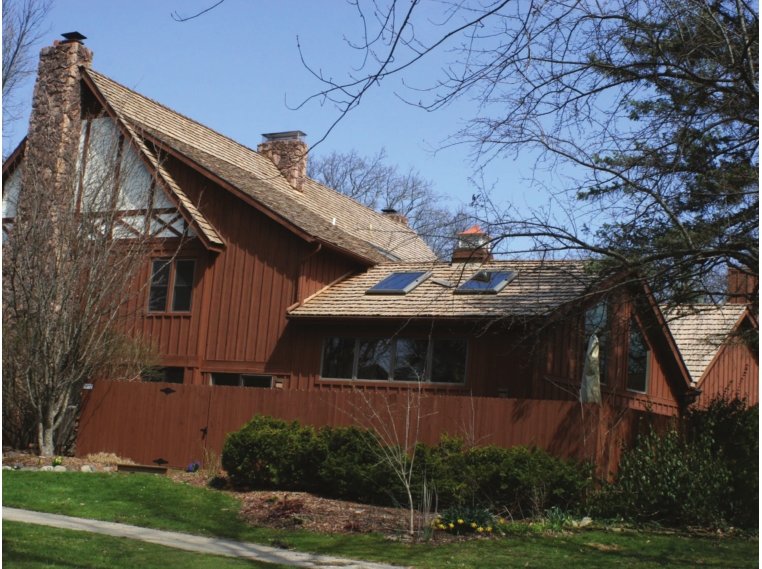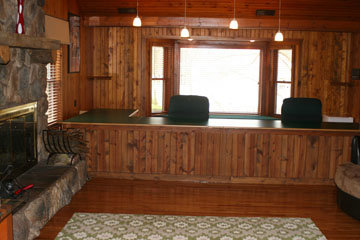
The Tudor-ish pile at 1141 Southlawn Avenue in East Lansing tells a whopper that’s brash and unsubtle enough for 1980s Hollywood.
The elevator pitch: At the height of the Reagan era, a huge, wood-paneled Aspen lodge with five fireplaces and a stone-grotto indoor pool is dumped onto an ordinary Midwestern ranch house by an Air Force transport. Let’s try for Tom Cruise as the pilot.
Do we get a green light to flesh that into a treatment? Great.
The house belonged to MSU English professor and big-time screenwriter Jim Cash, co-author of “Top Gun,” 1986’s top-grossing film and a cult classic. Cash lived in the house from 1980 until his death in 2000 at age 59.
It’s up for sale now; its latest owners moved out of town in January. The chance to peek inside Cash’s stronghold — a lavish slab of Malibu packed into a tiny East Lansing lot with barely a fringe of yard to spare — was too much fun to resist.
Longtime friend Etta Abrahams met Cash in the spring of 1963, when Cash was fiction editor of the Red Cedar Review, the campus literary journal.
“He was living the writer’s life, meaning he was poor,” Abrahams said.
As a grad student, Cash lived over the old Cunningham Drugs at Abbot Road and Grand River Avenue in a one-room apartment.
“He had the empty bottle of Chianti with the typical dripping candle in it, and he loved Hemingway,” Abrahams said.

One day in the early 1980s, when Abrahams was a professor at MSU, Cash excitedly burst into her office. He had just sold his first screenplay. “Izzy & Moe,” a TV movie for “The Honeymooners” stars Jackie Gleason and Art Carney, aired on CBS in 1985.
“It enabled him to buy the house on Southlawn,” Abrahams said. “It was a single-story, normal brick ranch house.”
But not for long.
In the 1980s, Cash struck up a long-running screenwriting partnership with Jack Epps Jr., a former student. The team co-wrote “Legal Eagles,” starring Robert Redford; “Turner & Hooch,” starring Tom Hanks; “Secret of My Success,” starring Michael J. Fox; and “Dick Tracy,” featuring Warren Beatty and Madonna.
Epps had a knack for plot, while Cash excelled at dialogue. They rarely saw each other in their working years and collaborated long-distance, via computer.
The duo’s biggest hit was “Top Gun.” The success of the flag-waving Tom Cruise vehicle allowed Cash to triple the size of his house. He hunkered in with his wife, Cynthia, three kids and a menagerie of cats, dogs and even squirrels — in cages.
Cash’s second-floor office alone is the size of a lakeside cabin, paneled in pine and featuring a massive stone fireplace. There’s a City Council-sized, 12-foot-long table where he spent thousands of hours working, swiveling in a big red chair and looking out of the window at the surrounding Glencairn Neighborhood.
The room adjoins a walk-in library/ closet, complete with a ladder on rollers. The library was packed with books and old magazines, many of them used to research the time periods depicted in his screenplays. The shelves still have Cash’s alphabetized labels. (The library/ closet was also his hiding place for pot, according to sources who asked not to be named.)
“It’s a poor kid’s idea of what it means to be a rich kid,” Abrahams said. “Before all that was built, he lived like a graduate student — boards and bricks and colored lights.”
The downstairs indoor pool is a blue lagoon of schmooze in a cozy cave of stone and pine. Flat surfaces for drinks are nowhere more than a step or two away from the water.
The additions reduced Cash’s lawn maintenance chores to a hilarious minimum in a neighborhood loaded with expansive landscaping.
Cash had more motivation than silver screen exuberance to maximize the interior. He suffered from mild agoraphobia and rarely left the house. Even his MSU screenwriting classes gathered at his second-floor office/den, where he screened films for them. Abrahams was one of Cash’s students.
“He was an excellent teacher, very lively, gave us great criticism, great exercises,” she said.
Every time a Cash/Epps opus came out, Cash threw a big party. The biggest was the “Top Gun” bash after the film’s local premiere at the Campus Theatre in 1986.
“Anybody who was anybody at the university or in the writing community was there,” Abrahams said.
The parties were lively, but not “The Day of the Locust” lively, despite the pot smoking. Cash and his wife both had a religious side.
At a reception at MSU’s Cowles House, Abrahams found him wearing a “huge crucifix” over a black turtleneck.
“My God, what is that?” she asked him.
“Well, you know, people change,” he told her.
“He got more conservative as he got richer, but I don’t think the money changed him,” Abrahams said. “He was always Jim.”
By 2000, the “Top Gun” days were past and Cash and Epps were happily slumming with screenplays for “Anaconda” (with Ice Cube and Jennifer Lopez) and “The Flintstones in Viva Rock Vegas.”
That year, Cash was hit with peritonitis.
“He didn’t know he had it,” Abrahams said. “He thought he had the flu. Six weeks later he was dead.”
The house sat empty and fell into disrepair for a while. Its next owner was Mary Ellen Sheets, founder of the Two Men and a Truck moving company. In 2011, Don Heller, then dean of MSU’s College of Education, and his wife, Anne Simon, took it over. They moved to California in January when Heller was appointed provost and academic vice president of the University of San Francisco.
Simon credits Sheets for fixing up the house and keeping many of its most characteristic features.

While professing “no belief or disbelief” in the hereafter, Simon said “there are certain things that happened in the house that are kind of odd.” She spent a lot of time alone at Cash’s old desk, going over household bills and other work, alone. Sort of.
“I’d have this overwhelming feeling somebody was looking over my shoulder,” she said. “Nothing sinister, not an evil feeling. It was almost like he left this earth too quickly and he was just checking in on his house.”
Support City Pulse - Donate Today!
Comments
No comments on this item Please log in to comment by clicking here